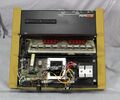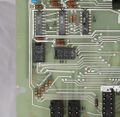1657: Difference between revisions
Jump to navigation
Jump to search
(→Photos) |
(→Photos) |
||
| Line 49: | Line 49: | ||
GR 1657 Power Supply Top.jpg | GR 1657 Power Supply Top.jpg | ||
GR 1657 Power Supply Close-Up.jpg | GR 1657 Power Supply Close-Up.jpg | ||
GR 1657 Display Board Component Side | |||
GR 1657 Display Board Foil Side.jpg | |||
GR 1657 Main Board Component Side.jpg | |||
GR 1657 Main Board Diagnostic Ports.jpg | |||
GR 1657 Main Board Foil Side.jpg | |||
GR 1657 20uf Electrolytic Measurement.jpg | |||
GR 1657 33 Ohm Measurement.jpg | |||
</gallery> | </gallery> | ||
Revision as of 03:59, 30 May 2024
The General Radio 1657 Digibridge is a digital RLC meter, introduced in 1976 1.
Specifications
please add
Links
- Henry P. Hall
- US Patent 4342089, Henry P Hall, Method of and apparatus for automatic measurement of circuit parameters with microprocessor calculation techniques. Filed Dec 12, 1979; Granted July 27, 1982
- How to measure R, C, L using vintage LCR meter @ YouTube
- Gipe, M.A., Hall, H.P. and Sullivan, R., "Microprocessor Simplifies Impedance Measurements", Session 1, Paper #4, Wescon 1976
- Hall, H.P., "Analog tests: the microprocessor scores" IEEE Spectrum, April 1977
- 1657 description, disassembly and Verilog simulation @ tauntek.com
Internals
The 1657 applies a sine wave to the measured device and a precision resistor in series. The average voltage across each is measured using four different phases relative to the input sine wave, for a total of eight measurements. From these, the resistive and reactive components of the tested device are calculated and displayed.
The 1657 uses a 6503 CPU, which is a 28-pin version of the 6502 with the same instruction set, but fewer address lines. The 1657's firmware is contained in a 2Kx8 ROM, in later versions a 2716 EPROM. A 128-byte SRAM holds scratchpad and the stack.
Photos
















